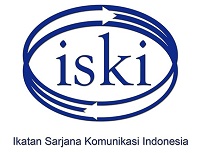Inclusive Journalism on Disability News in TribunSumsel.com during Covid 19 Pandemic Era
Abstract
Keywords
Full Text:
PDFReferences
Adytya, B. (2021, Maret 22). Kisah pedih Janudin, nelayan difabel kaki tak sempurna, berjuang demi sesuap nasi. Merdeka. https://www.merdeka.com/trending/kisah-pedih-janudin-nelayan-difabel-kaki-tak-sempurna-berjuang-demi-sesuap-nasi.html , diakses tgl 30 Maret 2022
Alenaizi, H. M., & Alshammari, S. (2021). A Critical Content Analysis of Kuwaiti TV Shows and Plays on Disability Representations. Arab Media & Society, 31, 61-80.
Al-Zoubi, S.M, Al-Zoubi, S.M. (2022). The Portrayal of Persons with Disabilities in Arabic Drama: A Literature Review. Research in Developmental Disabilities, 125 (2022): 1-8. DOI: https://doi.org/10.1016/j.ridd.2022.104221
Anton, T. (2016). Portrayals of People with Disabilities in Indonesian Newsprint Media (A Case Study on Three Indonesian Major Newspapers) . IJDS 3(1), 1 – 11.
Auslander, G. K., & Gold Nora. (1999). Disability terminology in the media: a comparison of newspaper reports in Canada and Israel. Social Science & Medicine, 48, 1395–1405.
Denzin, N. K., & Lincoln, Y. S. (2018). The SAGE Handbook of Qualitative Research Fifth Edition. Los Angeles: SAGE Publications.
Englandkennedy, E. (2008). Media Representations of Attention Deficit Disorder: Portrayals of Cultural Skepticism in Popular Media. Journal of Popular Culture, 41(1), 91-117
Entman, R. M. (1993). Framing: Toward clarification of a fractured paradigm. Journal of Communication, 43(4).
Eriyanto. (2005). Analisis Framing: Kontsruksi, Ideologi, dan Politik Media. Yogyakarta: LKiS.
Farnall, O., & Smith, K. A. (1999). Reactions to people with disabilities: Personal contact versus viewing of specific media portrayals. Journalism & Mass Communication Quarterly, 76, 659–672.
Ford, R., Gonzales, S., & Quade, V. (2020). Collaborative and Inclusive Journalism: More Than Words. Journalism & Mass Communication Educator, 75(1), 58–63
Gilbert, A., MacCauley, M. I., & Smale, B. J. (1997). Newspaper portrayal of persons with disabilities over a decade. Therapeutic Recreation Journal, 31, 108–120.
Green, K., & Tanner, S. (2009). Reporting Disability. Research Online: Reporting Vulnerability, 19, 43–54.
Grue, J. (2016). The problem with inspiration porn: a tentative definition and a provisional critique. Disability & Society, 31: 838 - 849.
Hafiar, H., Dewi, R., & Puspitasari, L. (2017). Pengadaan Media Literasi melalui Cerita Bergambar. MediaTor 10(2), 216-226.
Haller, B., Dorries, B., & Rahn, J. (2006). Media labeling versus the US disability community identity: A study of shifting cultural language. Disability & Society, 21, 61–75.
Johnson-Cartee, K. (2005). News narratives and news framing: Constructing political reality. Rowman & Littlefield Publishers.
Kulkarni, M., Gopakumar, K. v, & Vijay, D. (2017). Institutional discourses and ascribed disability identities. IIMB Management Review , 29, 160–169.
Kurnia, N., Wendratama, E., Monggilo, Z. M., Utomo, W. P., & Rahayu. (2021). Modul Jurnalisme Inklusif: Liputan Tentang Perempuan, Anak, dan Difabel Selama Pandemi. Yogyakarta: Departemen Ilmu Komunikasi Universitas Gadjah Mada.
Lancaster, K., Hughes, C. E., Spicer, B., Matthew-Simmons, F., & Dillom, P. (2011). Illicit drugs and the media: Models of media effects for use in drug policy research. Drug and Alcohol Review, 30, 397–402.
Langtree, I. (2017, January 29). Disability: Definition, types and models. Retrieved from
https://www.disabled-world.com/disability/types/, diakses tgl 1 April 2022
Mahyudin. (2019). Sosiologi Komunikasi Dinamika Relasi Sosial di Dalam Era Virtualitas. Makassar: Penerbit Shofia.
Niyu. (2017). Representasi Disabilitas dalam Iklan “We’re the Superhumans”. INKLUSI: Journal of Disability Studies, 4 (1): 49-70.
Pirls, D., & Popovska, S. (2013). Media Mediated Disability: How to Avoid Stereotypes. International Journal of Scientific Engineering and Research (IJSER) 1(4),, 42-45.
Ross, Karen. (1997). But Where’s Me in It? Disability, Broadcasting and the Audience. Media Culture Society, Vol. 19: 669-677
Rupar, V., & Zhang, C. (2022). Inclusive Journalism. Media Diversity Institute.
Rupar, V., & Pesic, M. (2012). Development of Journalism Education and Rebuilding Democracy. In Hamada, B. (ed) Rebuilding Egyptian Media for a Democratic Future [in Arabic]Cairo: Dar Alam al-Kuttub, pp 154-171
Rupar, V., & Pesic, M. (2012). Development of Journalism Education and Rebuilding Democracy. In Hamada, B. (ed) Rebuilding Egyptian Media for a Democratic Future [in Arabic]Cairo: Dar Alam al-Kuttub, pp 154-171
Saito, S., & Ishiyama, R. (2005). The invisible minority: under-representation of people with disabilities in prime-time TV dramas in Japan. Disability & Society, 20(4), 437-451.
Satriani, A. (2018). Framing Analysis of News Article about Clashes between Police and Terrorist Prisoners in Indonesia Publishing by ABC.net.au and SBS.com. MediaTor 11(2), 248-255.
Schmiesing, A. (2014). Disability, Deformity, and Disease in the Grimms’ Fairy Tales. Michigan: Wayne State University Press
Setyowati, R. M., Watie, E. D., & Saptiyono, A. (2020). Representation of Disability Achievements in Television Talk Show Programs. Jurnal The Messenger, 40-51.
Thaniago, R. (2020). Indeks Media Inklusif 2020: Rapor Jurnalisme Daring dalam Pemberitaan Kelompok Marginal di Indonesia. Remotivi.
Tuchman, G. (1973). Making news by doing work: Routinizing the unexpected. Journal of Sociology, 79, 110–131.
Tuneva, M. (2011). Diversity Reporting Handbook. School of Journalism and Public Relations.
Von Sikorski, C., & Schierl, T. (2012). Effects of news frames on recipients’ information processing in disability sports communications. . Journal of Media Psychology: Theories, Methods, and Applications, 24, 113–123.
Watie, E. D. S. (2010). Representasi Wanita Dalam Media Massa Masa Kini. Jurnal The Messenger, 2(2), 1–10.
Wicaksono, D., Suryandari, N., & Camelia, A. (2021). Stereotip Tentang Difabel: Sebuah Perspektif Komunikasi Lintas Budaya. Interaksi, 10(1), 33-43.
Ye, W., & Zeldes, G. A. (2020). The Representation of People With Disabilities in an Official Newspaper in China: A Longitudinal Study of the People’s Daily From 2003 to 2013. Journal of Disability Policy Studies, 31(1), 26–34.
Yuniati, Y., & Fardiah, D. (2017). Citra Caleg Perempuan dalam “Framing” Media “Online”. MediaTor, 10 (1), 75-86.
Zhang, L., & Haller, B. (2013). Consuming image: How mass media impact the identity of people with disabilities. Communication Quarterly, 61, 319–334.
DOI: https://doi.org/10.29313/mediator.v15i2.10351
Refbacks
- There are currently no refbacks.

This work is licensed under a Creative Commons Attribution 4.0 International License























